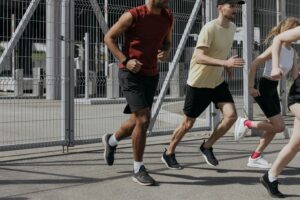Disclosure: Some links in this post may be affiliate links. This means I may earn a small commission if you purchase through them—at no extra cost to you. I only recommend gear I personally use and believe in!
As a new runner, you’ve probably noticed people wearing running vests or belts during their workouts. You might’ve even seen them in TikTok videos or at your local park. So, do you need one? And if so, when should you use it?
The short answer: it depends on your distance and what you’re carrying. But don’t worry—I’ll break it all down so you can decide what works best for your running journey.
What’s the Difference Between a Running Vest and a Running Belt?
- Running belts are lightweight bands that wrap around your waist and are great for carrying essentials like your phone, keys, energy gels, or small water bottles.
- Running vests are worn like a backpack and can carry more gear and water. They’re ideal for longer distances or trail running.
When I Use a Running Belt
I personally use a running belt for any run between 3–6 miles, especially if I’m not running in my neighborhood or need to drive to a trail or park.
My go-to is the Airuntech Hydration Running Belt—it’s affordable, stays securely in place, and doesn’t bounce or cause chafing. The main pocket fits my phone and car key fob easily, and it comes with two water bottles to keep me hydrated on the go. It also has loops for gel packets (although note: some narrower gels may slip out).
For short to mid-distance runs, this belt does exactly what I need—holds my stuff, stays comfortable, and helps me hydrate without having to carry anything in my hands.
When I Use a Running Vest
For anything over 6 miles—especially long runs and half marathon training—I switch to a hydration vest. Even if I’m running close to home, I prefer having more water and hands-free storage.
I found a Nathan hydration vest at Walmart (surprisingly, it was designed for hiking, not running—but it worked great!). It has two large front pockets where I keep my phone, energy gels, and even trash from used gels. For my half marathon, I carried:
- Phone
- 4 energy gels
- Gel wrappers
- Car keys
- KT tape
- Anti-chafing balm
- Spare shirt
The back pocket was spacious, and the vest included a 1.5-liter hydration bladder, which was perfect for long-distance hydration. The adjustable straps helped keep everything stable without any annoying bounce.
While this model wasn’t specifically made for running, it still worked well—so I imagine a dedicated running vest from Nathan would be even better.
Why Consider a Running Vest or Belt?
Whether you’re running 3 miles or training for a half marathon, here’s why a vest or belt can level up your run:
✅ Stay Hydrated – Carry water with ease without needing a water fountain
✅ Carry Essentials – Keep your phone, ID, gels, keys, or even a small snack on hand
✅ Hands-Free Running – Run more comfortably without juggling gear
✅ Emergency Ready – Carry first aid items, energy gels, or even your inhaler if needed
✅ More Comfortable – Better than overloading your pockets or running with items in your hand
✅ Ideal for Trails & Races – Stay prepared when you’re far from home or aid stations
Final Thoughts
No matter what gear you choose, the goal is to be prepared, hydrated, and comfortable. A running vest or belt helps you run smarter—especially as your distances increase.
Even if it’s just to hold your phone or wallet, it can make a big difference in how confident and comfortable you feel on your runs.
I hope this guide helps you decide what’s best for your needs! Want weekly motivation, gear tips, and beginner running advice?
